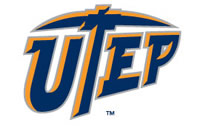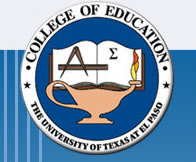
Bill Robertson, Ph.D. - Classes
Teacher Education Department
TED 5319 - Educational Web Site Design and Development
Syllabus ( Available in PDF)
Available in PDF)
Instructor: Dr. Bill Robertson
Phone: 747-8608
Office: Education Building, Room 604
Email: robertson@utep.edu
Class Website: http://utminers.utep.edu/robertson/classes/ted5319/default.htm
Office hours: By Appointment
Class Meetings
5:30 pm - 10:20 pm
May 18, 2006 - May 29, 2009 (No Meeting on May 25 - Memorial Day)
Education Building 405
Course Prerequisites
Admission to Graduate School
Incoming Competencies Expected of Students
Students should have a familiarity with Windows Operating System and functional
use of the Internet and Email. Students should also have a basic understanding
of the organization of folders and files on a computer. Previous use of
Internet software tools is recommended.
Textbook
Williams, Robin and Tollet, John (2006). The Non-Designer’s Web Book, (Third Edition) Peachpit Press, Berkeley, CA, ISBN # 0-321-30337-7.
Required Software
Dreamweaver MX 2004 (Educational or Full Version) is the professional choice for building web sites and applications. It provides a powerful combination of visual layout tools, application development features, and code editing support. Students will develop and post their own Web site on the UTEP domain as a final product.
Additional Resource Texts
Towers, Tapin (2001), Macromedia Dreamweaver for Windows
and Macintosh, Peachpit Press, Berkeley, CA, ISBN # 0-201-73430-3.
Graham, Ian S. (1998), HTML 4.0 Sourcebook, Wiley Computer,
New York, ISBN # 0-471-25724-9.
Other Course Materials
Additional Articles will be posted as links for students to read prior
to class and will be assigned daily.
Course Description
This course will explore Educational Web Site design and development.
Students will develop a functional Web site that integrates content and
graphics into a variety of Web interface strategies. Topics include HTML,
tables, links, graphics, templates, page layout as well as exploring related
software packages, including Macromedia Dreamweaver, Inspiration,
WS FTP and Internet Explorer.
The Phases of Educational Web Site Design and Development are centralized in five basic areas; planning, research, development, refinement and implementation. These five areas work as organizational frameworks for instruction and learning, Web site development and implementation, student progress and presentation. The scope and sequence of the content area matches the phases and allows for the integration of software tools for concept mapping, word processing, Web browsing, HTML code editing and file transferring.
Classes will be on weekday evenings from 5:30 to 10:20 PM, from May 18-29. About two hours of the class will be a lecture and guided instruction. The rest of each class will be classroom exercises, software engagement and Web Site development. There will also be online components to the class that will be woven into the instruction and will count as direct class time.
Course Goals
By the end of the nine session course, students should develop and demonstrate
their skills in the following areas:
- Communication - using a variety of technology tools and techniques for developing effective Web Sites that are functional and useful for the end user.
- Evaluation - making sense of the Internet, by learning how to assess other Web sites and implement effective strategies into the design and development of a personal Web site.
- Navigation - strategies for making a Web site that is intuitively understood by the Internet visitor as well as providing quality data and resources to the end user.
- Presentation - taking what makes sense in style and function and putting it to use with meaning and clarity as it relates to content and design.
Intended Course Outcomes
The intended course outcomes of this course are as follows:
- Successful learners will better understand and be able to integrate the basic concepts in designing, developing and maintaining a Web Site.
- Students will learn the relevance of the Phases of Web Site Development as a basis for managing Web Site development.
- Students will increase their understanding in the areas of HTML and related Internet software packages, such as Macromedia Dreamweaver.
- Students will design, develop and maintain their own personal Web site on the Internet through the UTEP Public Web Site.
Grading Policy
The grading scale will be:
A = 90% - 100%, B = 80% - 89%, C = 70% - 79%, D = 60% - 69%, F = 59% and
below.
The overall grade for the class for each student will be calculated as follows: 10% classroom participation, 20% mini-exams, 30% homework assignments, 20% Final Web Site Development, 20% Final Presentation of Web Site.
Schedule of Topics, Readings for Class and Assignments
| Session | Topic | Readings | Assignments |
1 |
Planning Phase | Chs. 1, 4 | Concept Map Development |
| 2 |
Research Phase | Chs. 2,3 | Analysis of Browsers |
3 |
Development Phase | Chs. 5,6,7 | UTEP Web Space/Intro Page |
| 4 |
Development Phase | Chs. 8,9 | Basic Web Site (textual) |
5 |
Development Phase | Chs. 10,11 | Basic Web Site (with graphics) |
| 6 |
Refinement Phase | Ch. 12 | Templates and Style Sheets |
7 |
Refinement Phase | Chs. 13, 14 | Interactivity Integration |
| 8 |
Implementation Phase | Chs. 15, 16 | FTP and Advanced HTML |
9 |
Final Presentations | None | Evaluation with Rubrics |
Syllabus | Schedule | Topics | Articles | Evaluation | Samples | Links

Bill Robertson, Ph.D. (robertson@utep.edu)
Teacher Education Department, College of Education, University of Texas at El Paso